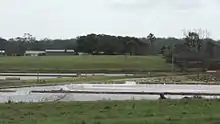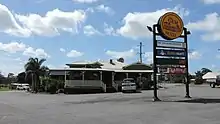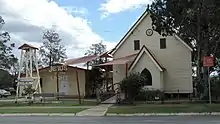| Alberton Gold Coast, Queensland | |||||||||||||||
|---|---|---|---|---|---|---|---|---|---|---|---|---|---|---|---|
 Sugarcane fields, looking south down Cane Farm Road, Alberton, 2022 | |||||||||||||||
 Alberton | |||||||||||||||
| Coordinates | 27°42′25″S 153°16′08″E / 27.7069°S 153.2688°E | ||||||||||||||
| Population | 590 (2016 census)[1] | ||||||||||||||
| • Density | 34.7/km2 (89.9/sq mi) | ||||||||||||||
| Postcode(s) | 4207 | ||||||||||||||
| Area | 17.0 km2 (6.6 sq mi) | ||||||||||||||
| Time zone | AEST (UTC+10:00) | ||||||||||||||
| Location |
| ||||||||||||||
| LGA(s) | City of Gold Coast | ||||||||||||||
| State electorate(s) | Coomera | ||||||||||||||
| Federal division(s) | Fadden | ||||||||||||||
| |||||||||||||||
Alberton is a rural locality in the City of Gold Coast, Queensland, Australia.[2] In the 2016 census, the locality of Alberton had a population of 590 people.[1]
Geography
Alberton is bounded in the north by the Logan River and in the west by its tributary, the Albert River.[3]
History

The Aboriginal name for the area was Wobbomerijee (where Wobum means mud and Mudtheri means sticky).[2]
European settlement began in 1863 when the first settlers arrived, mostly German immigrants.[4]
A town reserve was established in 1865 on the southern bank near the junction of the Logan and Albert Rivers.[5]
The Ageston sugar plantation and sugar mill operated from 1866 to the 1890s and was described as "one of the finest plants in the Moreton district" in 1873.[6]

In 1869, the first Lutheran church was established near the Lutheran cemetery on Zipfs Road. The area was known as Elkana (meaning "God has created and blessed").[4][7] A German school was established early in the 1870s beside the church.[4] In 1886, a new larger Lutheran church (the present St Peter's) was built. It was consecrated in 1887 by Rev Hellmuth.[4][8][9] The German school was demolished in 1919.[4]
Later the area was called Alberton after Prince Albert, consort to Queen Victoria, but the name Elkana is preserved in Elkana Road.[10]
The Alberton Ferry was established 1870 to cross the Logan River between Ferry Road at Carbrook and Alberton Road at Alberton (27°41′37″S 153°15′40″E / 27.6937°S 153.2611°E).[11] Following the opening of the Logan Bridge in 1931, usage of the ferry declined and it was closed in 1948.[12][4]
The Alberton Provisional School opened on 13 May 1876 with children attending German school on only one day a week.[4] On 13 October 1884 the provisional school became the Alberton State School.[13] It closed in 1966.[13][14] It was on a 10-acre (4.0 ha) site at 88 Alberton Road (corner of Zipfs Road, 27°42′39″S 153°15′35″E / 27.7109°S 153.2596°E).[11][15][3]
In October 1886, a well-known property on the Albert River owned by W. K. Witty called "Yellowwood Estate" was advertised for subdivision into suitable sized farms and then auctioned by Simon Fraser & Son.[16] A map advertising the auction states that 40 choice farms were available and the auction was to be held on Saturday 27 November at the Palm's Hotel, Beenleigh.[17]
The Gem Hotel was established in 1877 but it was destroyed by fire on 27 June 1933 but was insured.[10][18] By December 1933, the hotel had been rebuilt.[19][20]
In the 1950s, a very notable Bora ceremonial site on the Logan river was destroyed, and replaced with a pineapple plantation owned by a Mr Inklemann. The site bore the characteristics of the classic twin circles, with a north-south orientation, the large northern ring measuring 70–80 feet in diameter, while the smaller ring lay some 100 feet to its south. In the middle of the latter was a native stone hut, consisting of several stone slabs supporting a stone roof, not unlike the dolmen structures of prehistoric Europe.[21]
In the 2011 census, the locality of Alberton had a population of 576.[22]
In September 2012, an archaeological dig was undertaken on the former Ageston sugar plantation, revealing stone and steel structures, a Cornish boiler and evaporating pans.[6]
In the 2016 census, the locality of Alberton had a population of 590 people.[1]
Economy


Alberton is primarily a rural area with sugar cane plantations and prawn farms.[10]
Education
There are no schools in Alberton. The nearest primary schools are Woongoolba State School in neighbouring Woongoolba to the south-east and Mount Warren Park State School in Mount Warren Park to the south-west. The nearest secondary school is Beenleigh State High School in Beenleigh to the south-west.[3]
Facilities
AIberton Cemetery is at 80 Zipfs Road (27°42′42″S 153°15′58″E / 27.7116°S 153.2662°E).[23] Established by the German settlers, it is now operated by the Gold Coast City Council.[4][24]
Amenities
The Gem Hotel is on the corner of Stapylton-Jacobs Well Road and Rotary Park Road (27°43′15″S 153°15′08″E / 27.7207°S 153.2523°E).[20]

St Peter's Lutheran Church is at 187 Alberton Road (27°42′11″S 153°15′24″E / 27.7031°S 153.2566°E).[25]
The Gold Coast City Council operates a fortnightly mobile library service which visits St Peter's Lutheran Hall in Alberton Road.[26]
Alberton Cricket Club is in Zipf Park at 88 Alberton Road (27°42′41″S 153°15′34″E / 27.7115°S 153.2595°E).[27]
There is a boat ramp at the northern end of Alberton Road on the south bank of Logan River (27°41′37″S 153°15′39″E / 27.6937°S 153.2608°E). It is managed by the Gold Coast City Council.[28]
There are a number of parks in the area:
- Alberton Park (27°42′19″S 153°15′31″E / 27.7054°S 153.2586°E)[29]
- August Burow Park (27°41′43″S 153°15′35″E / 27.6954°S 153.2598°E)[29]
- Beitz Park (27°41′48″S 153°16′43″E / 27.6968°S 153.2785°E)[29]
- Woolshed Parklands (27°43′05″S 153°15′15″E / 27.7180°S 153.2543°E)[29]
- Zipfs Park (27°42′40″S 153°15′35″E / 27.7110°S 153.2597°E)[29]
References
- 1 2 3 Australian Bureau of Statistics (27 June 2017). "Alberton (SSC)". 2016 Census QuickStats. Retrieved 20 October 2018.
- 1 2 "Alberton – locality in City of Gold Coast (entry 48111)". Queensland Place Names. Queensland Government. Retrieved 18 September 2020.
- 1 2 3 "Queensland Globe". State of Queensland. Retrieved 4 February 2022.
- 1 2 3 4 5 6 7 8 "History". Alberton Lutheran Parish. Archived from the original on 24 January 2014. Retrieved 5 April 2014.
- ↑ "THE ALBERT RIVER". The Brisbane Courier. National Library of Australia. 16 November 1865. p. 3. Archived from the original on 2 February 2022. Retrieved 5 April 2014.
- 1 2 "Ageston Plantation Dig 2012". Gold Coast City Council. Archived from the original on 21 February 2018. Retrieved 21 February 2018.
- ↑ "LOGAN PIONEERS". The Brisbane Courier. National Library of Australia. 30 May 1914. p. 17. Archived from the original on 2 February 2022. Retrieved 5 April 2014.
- ↑ Blake, Thom. "St Peter's Lutheran Church (1869)". Queensland religious places database. Archived from the original on 3 February 2022. Retrieved 3 February 2022.
- ↑ Blake, Thom. "St Peter's Lutheran Church (1887)". Queensland religious places database. Archived from the original on 29 October 2021. Retrieved 3 February 2022.
- 1 2 3 "Alberton History". City of Gold Coast Council. Archived from the original on 27 September 2020. Retrieved 4 February 2022.
- 1 2 "Beenleigh" (Map). Queensland Government. 1947. Archived from the original on 11 June 2020. Retrieved 4 February 2022.
- ↑ "Alberton". Gold Coast City Libraries. 11 April 2017. Archived from the original on 3 June 2021. Retrieved 3 February 2022.
- 1 2 "Agency ID 6326, Alberton State School". Queensland State Archives. Retrieved 5 April 2014.
- ↑ "Opening and closing dates of Queensland Schools". Queensland Government. Retrieved 4 April 2014.
- ↑ "Queensland Forty Chain series sheet 612" (Map). Queensland Government. 1943. Archived from the original on 3 February 2022. Retrieved 4 February 2022.
- ↑ "Advertising". Logan Witness. Vol. IX, no. 445. Queensland, Australia. 30 October 1886. p. 2. Archived from the original on 22 May 2021. Retrieved 29 May 2019 – via National Library of Australia.
- ↑ "Yellow Wood Estate Albert River" [Map]. Collections. State Library of Queensland.
- ↑ "FIRE AT ALBERTON". The Brisbane Courier. National Library of Australia. 28 June 1933. p. 4. Archived from the original on 2 February 2022. Retrieved 14 April 2014.
- ↑ "Classified Advertising". The Courier-Mail. Brisbane: National Library of Australia. 11 November 1933. p. 5. Archived from the original on 2 February 2022. Retrieved 14 April 2014.
- 1 2 "Welcome". The Gem Hotel. Archived from the original on 15 April 2014. Retrieved 14 April 2014.
- ↑ Ponosov, Vladimir Vasil'evich (1974). Results of an archaeological survey of the Southern region of Moreton Bay and of Moreton Island (1963-1964) (PDF). University of Queensland. pp. 2, 69–70. Archived (PDF) from the original on 16 January 2017. Retrieved 14 January 2017.
- ↑ Australian Bureau of Statistics (31 October 2012). "Alberton (State Suburb)". 2011 Census QuickStats. Retrieved 20 January 2013.
- ↑ "Cemetery Areas - Queensland". Queensland Open Data. Queensland Government. 12 November 2020. Archived from the original on 15 November 2020. Retrieved 12 November 2020.
- ↑ "Alberton Cemetery". Gold Coast City Council. Archived from the original on 3 February 2022. Retrieved 3 February 2022.
- ↑ "St Peter's Lutheran Church :: Alberton Lutheran Parish". Archived from the original on 8 December 2021. Retrieved 3 February 2022.
- ↑ "Mobile Library 2018 timetable" (PDF). Gold Coast City Council. Archived from the original (PDF) on 30 January 2018. Retrieved 30 January 2018.
- ↑ "Building points - Queensland". Queensland Open Data. Queensland Government. 17 November 2020. Archived from the original on 25 November 2020. Retrieved 25 November 2020.
- ↑ "Recreational Boating Facilities Queensland". Queensland Open Data. Queensland Government. 12 November 2020. Archived from the original on 22 November 2020. Retrieved 22 November 2020.
- 1 2 3 4 5 "Land for public recreation - Queensland". Queensland Open Data. Queensland Government. 20 November 2020. Archived from the original on 22 November 2020. Retrieved 22 November 2020.
External links